During
four college years in Hanoi, I assumed I knew a good bun cha place when I saw one: blue plastic stools, sizzling pork on
the sidewalk, thick smoke curling up, and inside, the sound of chomping mouths.
Before
college, I lived in my northern hometown where bun cha is nothing close to the original. As a first-timer, I
embraced bun cha Hanoi with
gratefulness and free of judgement, to start with.
As
the thrill gradually faded, I grew less random and a bit pickier. In Hanoi,
once every few weeks food-rating apps would wax lyrical about some decades-old
family bun cha legacy. I, like almost
everyone, would rush to the new place, assuming olden is golden.
In
Hanoi, many family-run bun cha businesses
date back to the forties and fifties, before the American War and the subsidy
period.
In
the book Hanoi Delicacies, Vu Bang, a Vietnamese writer, spy and famous foodie
who lived around that time, left an invaluable insight on the bun cha scene in the capital:
“There
isn’t an outstanding bun cha stall in
Hanoi,” Bang wrote. “Not because they aren’t doing a great job, but indeed
because everyone is nearly equally good.”
Around
seven decades later, I can assure Mr. Bang some of the best have fallen far
behind.
Last
October, I visited a popular 40-year-old shop in the Old Quarter expecting the
traditional method of grilling the meat in bamboo the food-rating apps had
spoken of. What I found was a salty bowl full of charred meat.
“My
stall is too crowded from 11 a.m. to 2 p.m. How am I supposed to find the time
for bamboo sticks?” said the owner, who inherited the business from her mother.
Like
many stalls "burdened" by so many customers, the owner has chosen to
switch from the traditional method of slow bamboo grilling to supercharged
electric fans and metal grills.
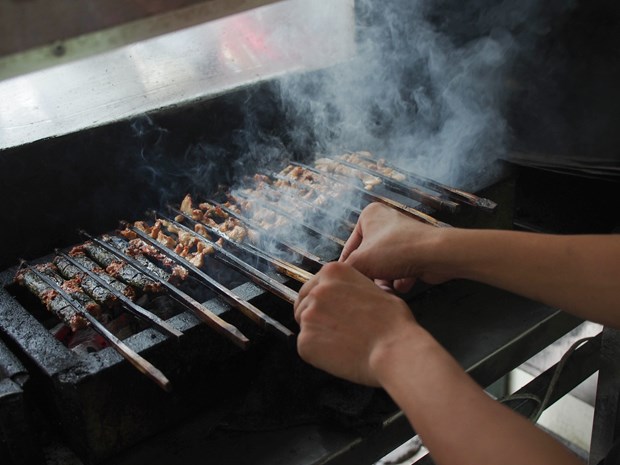
The traditional bamboo grilling method. Photo by VnExpress/Quynh Trang
Indeed,
after stopping by several popular bun cha
spots, I was told the bamboo method did not make business sense, and that
no one uses it any more.
Yet
mouth-watering paragraphs taken by Vu Bang and the lively reminiscing of Chef
Nguyen Phuong Hai, an expert in traditional Hanoi cuisine, kept me hankering
for what old Hanoians used to be so lucky to have.
“You
take cha (grilled pork) off the
bamboo sticks, toss it in the sauce and start eating," Hai said. “A nice bun cha must be rich with the smell of
pork, fish sauce, spring onions and pepper. The bowl must not be too big, and
the cha must not smell smoky.”
By
my own standards, the dream bowl would look pleasant with a reasonable amount
of cha evenly drenched in tasty
sauce, leaving no piece cold, dry or stale on top.
Bearing
in mind all the criteria, I, resenting charred bits and bitterly salty sauce,
was determined to find the perfect bowl.
After
over a dozen attempts in the past few months, I didn’t find just one, I found
three.
Bamboo bun cha with a
shrimp twist
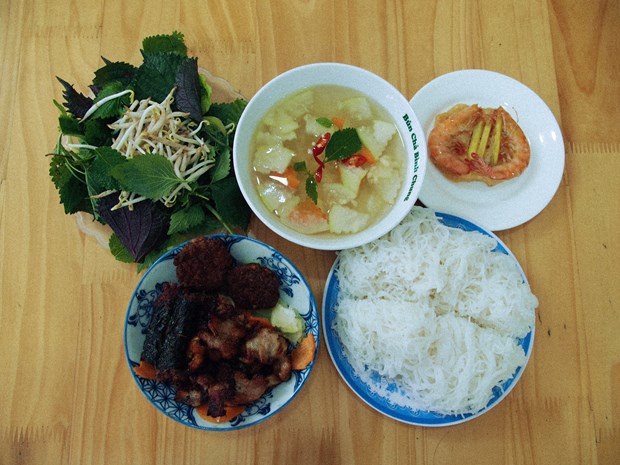
Bun cha Binh Chung with separate grilled pork and shrimp cake. Photo by VnExpress/Quynh Trang
When
former U.S. President Obama and food expert Anthony Bourdain shared a beer and
a bowl of bun cha at Huong Lien’s
restaurant last year, Bun cha Binh Chung wasn’t there on the same street.
Just
last month, the 71-year-old brand opened its second stall a block away from
Huong Lien’s, which is now commonly known as “bun cha Obama”. Huan, 33, quit his job at a top Vietnamese telecoms
firm to sell bun cha full-time.
“Why
work for someone else when you can have your own business?” Huan said, wearing
a striped blue shirt and black trousers like he had just walked out of the
office.
Huan’s
father was a bun cha junky and he
himself spent much of his childhood fanning barbecues. His grandmother, Binh
Chung, sold bun cha during the French
assault known as Operation Lea in the forties and became known in Hanoi through
the subsidy period.
“My
grandmother sold both pho and bun cha and there’s a story about her
food,” Huan said. “In the 70s, only well-off people could afford a meal at our
shop.”
I
wasn’t able to confirm whether that tale is true or not, but I know one thing
for sure, it still uses the traditional bamboo grilling method I had been
looking for.
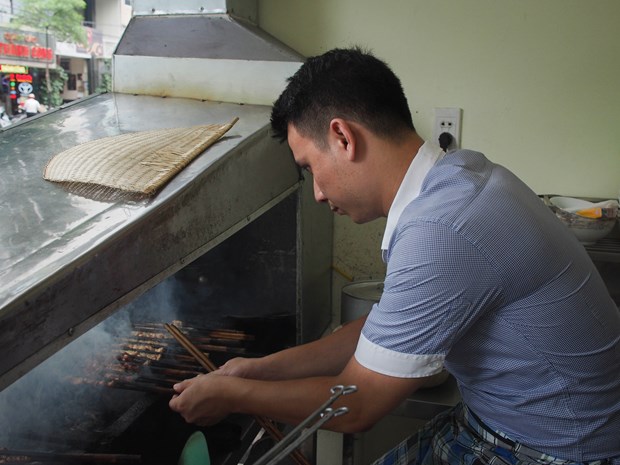
Huan, the owner, tends to each bamboo stick carefully before serving customers. Photo by VnExpress/Quynh Trang
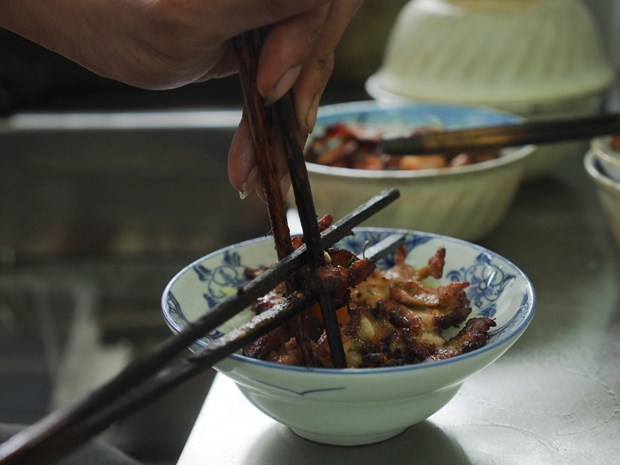
At Bun Cha Binh Chung, you can ask for the grilled pork to be served separately from the sauce. Photo by VnExpress/Quynh Trang
The
best part? You can ask for the cha to
be served separately from the sauce, just like old times, and it comes with a
shrimp cake which goes perfectly with the sauce.
Huan
serves four specialties: chopped pork wrapped in chapa leaves and grilled on
bamboo sticks, pork belly, pork patties and the shrimp cake.
I
couldn’t decide for myself which was the best since they were all equally
delicious, but the shrimp cake truly deserves a reward for creativity.
Bun cha Binh Chung
299 Bach Mai & 88
Le Van Huu
Price range: VND
50,000 – 60,000 ($2.2- 2.64)
The new born bun cha
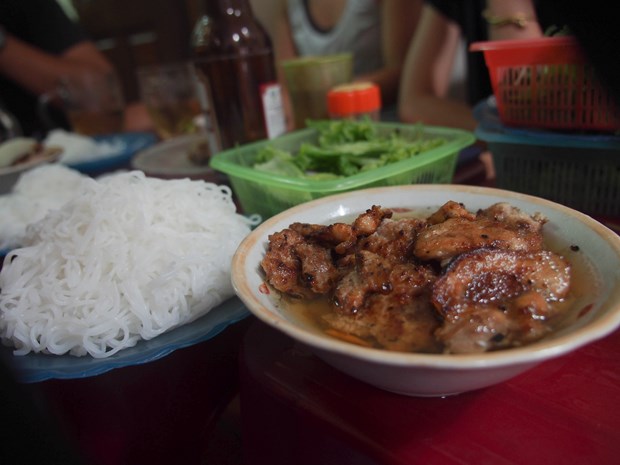
Bun cha nem ran at 216 Doi Can. Photo by VnExpress/Quynh Trang
I
tried to keep an open mind on my search for the perfect bun cha, leaving out the family legacy factor, but I couldn't get
over my own bias of expecting more from an old shop than a new one. That
changed when I had lunch at Hong’s.
The
shop is named quite simply after the dish: Bun
cha nem ran. The number is 216, and it stands among dozens of other 216s
due to the odd house-numbering in Vietnam.
Yet
inside, inviting bowls of bun cha are
being served. Sizzling slices of chopped pork protrude just above the sauce.
The bowl is elegant enough to not be mistaken for a bowl of pho, yet big enough for the cha to be fully immersed.
“There’s
no family secret,” said Hong, the 46-year-old owner. “Seven years ago I tried
dozens of bowls of bun cha from
around the capital and then tried to make my own.”
Hong’s
meal is minimalistic: just the golden, soft cha
in a fresh, char-free sauce, with a snow-white dish of bun on the side.
If
you want a meal to brighten up your drowsy afternoon, find Hong sitting on a
blue stool in front of a narrow, rustic door on Doi Can Street.
Bun cha nem ran
216 Doi Can, Ba Dinh,
Hanoi
Price: VND30,000 ($1.3)
Hustling bun cha

Hung, the owner, oversees a total of four semi-detached shops. Photo by VnExpress/Quynh Trang
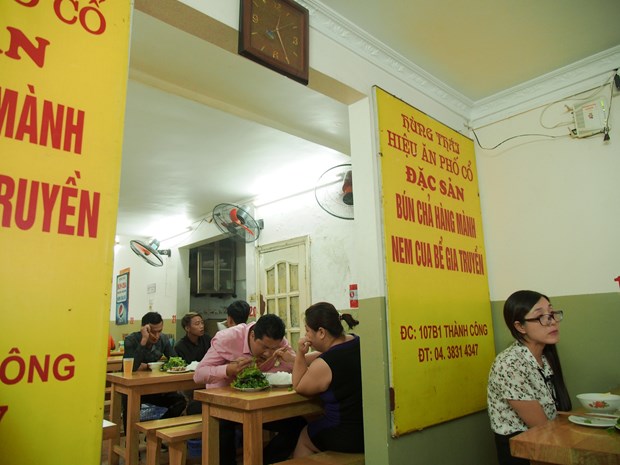
Inside the hustling Bun Cha Hung Thai. Photo by VnExpress/Quynh Trang
Hang
Manh Street in the Old Quarter was once famous for bamboo curtains (manh in
Vietnamese) and bun cha.
Each
bun cha shop on the street took its
owner's name, but always attached the street brand as a reminder of
authenticity.
Today,
competition on Hang Manh is so fierce that some shops have put up signs
bad-mouthing their rivals.
Bun cha Hung Thai, originally located on
Hang Manh Street, escaped the hustle, and now its owner Nguyen Van Hung has
created a mini-empire just six kilometers from the Old Quarter.
Hung
oversees a total of four semi-detached shops and around 10 employees, all alert
to any potential customers who pass by, not that there's much need.
“We’re
too busy already, no need to write about us,” shouted Hung’s wife, tending to
four electric stoves that churn out hundreds of dishes each day.
What
could be more attractive than a shop that doesn't want more customers? Set a
date for Bun Cha Hung Thai, but make sure you get there early to tuck into
their freshest bites.

Bun cha Hung Thai. Photo by VnExpress/Quynh Trang
Bun cha Hung Thai
107 B1 Thanh Cong, Ba
Dinh District, Hanoi
Price range:
VND30,000-50,000 ($1.3-2.2)
By VnExpress